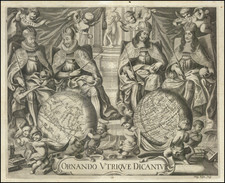From one of the Very Last Editions of the Atlas.
Attractive example of the decorative title page from the 1612 Latin edition of Ortelius' Theatrum Orbis Terrarum, the first modern atlas. This nice full-color piece contains lettering heightened in gold.
The four figures surrounding the title represent the four known continents, with an Amazon at the bottom, a representation of Africa at the right, a representation of Asia at the left, and a representation of Europe at the top. Two globes surround the representation at the top.
Text on the map ascribes the work to Ortelius, geographer to the king. At the bottom, it mentions his connection with the Plantin family, an important Antwerp printing family at the time.
The verso includes a reference to Philip II along with his coat of arms. The king Ortelius's patron after the Spanish takeover of the Low Countries.\
This title page originally appeared in the 1612 Latin edition of the Theatrum, the last edition to be published.
Abraham Ortelius is perhaps the best known and most frequently collected of all sixteenth-century mapmakers. Ortelius started his career as a map colorist. In 1547 he entered the Antwerp guild of St Luke as afsetter van Karten. His early career was as a business man, and most of his journeys before 1560, were for commercial purposes. In 1560, while traveling with Gerard Mercator to Trier, Lorraine, and Poitiers, he seems to have been attracted, largely by Mercator’s influence, towards a career as a scientific geographer. From that point forward, he devoted himself to the compilation of his Theatrum Orbis Terrarum (Theatre of the World), which would become the first modern atlas.
In 1564 he completed his “mappemonde", an eight-sheet map of the world. The only extant copy of this great map is in the library of the University of Basel. Ortelius also published a map of Egypt in 1565, a plan of Brittenburg Castle on the coast of the Netherlands, and a map of Asia, prior to 1570.
On May 20, 1570, Ortelius’ Theatrum Orbis Terrarum first appeared in an edition of 70 maps. By the time of his death in 1598, a total of 25 editions were published including editions in Latin, Italian, German, French, and Dutch. Later editions would also be issued in Spanish and English by Ortelius’ successors, Vrients and Plantin, the former adding a number of maps to the atlas, the final edition of which was issued in 1612. Most of the maps in Ortelius' Theatrum were drawn from the works of a number of other mapmakers from around the world; a list of 87 authors is given by Ortelius himself
In 1573, Ortelius published seventeen supplementary maps under the title of Additamentum Theatri Orbis Terrarum. In 1575 he was appointed geographer to the king of Spain, Philip II, on the recommendation of Arias Montanus, who vouched for his orthodoxy (his family, as early as 1535, had fallen under suspicion of Protestantism). In 1578 he laid the basis of a critical treatment of ancient geography with his Synonymia geographica (issued by the Plantin press at Antwerp and republished as Thesaurus geographicus in 1596). In 1584 he issued his Nomenclator Ptolemaicus, a Parergon (a series of maps illustrating ancient history, sacred and secular). Late in life, he also aided Welser in his edition of the Peutinger Table (1598).











![[Title page] Uranographia, sive Astrorum Descriptio](https://storage.googleapis.com/raremaps/img/small/77921.jpg)
![Gerardus Mercator . . . [and] . . . Iudocus Hondius . . .](https://storage.googleapis.com/raremaps/img/small/78439.jpg)

![[Title Page - Backwards World Map! / California as an Island]](https://storage.googleapis.com/raremaps/img/small/41754.jpg)
![[Title Page] Niewen Atlas . . . (Heightened in Gold!)](https://storage.googleapis.com/raremaps/img/small/42763.jpg)
![[Title Page] New Universal Atlas](https://storage.googleapis.com/raremaps/img/small/101111.jpg)